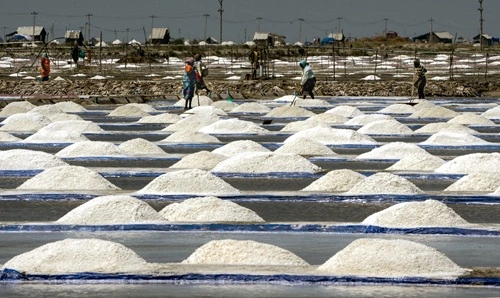Salt is an essential mineral that is used for human consumption, chemicals, textiles, food processing, and many industrial applications. Among the world’s top producers of salt, India is the third-largest producer of salt. All this became possible through the extensive coastline, favourable climate for solar evaporation, and large saline lakes.
Salt production in India started centuries ago, and the amount is gradually increasing every year. In the past few years, the salt production has reached approximately 31 tonnes on an annual basis, where common salt, like sea, lake brine, and rock, is produced for consumption. Many states contribute to salt production, with a few states accounting for the majority of national production.
Salt is crucial, not just for consumption, but for the health and economy of the country as well. The top 5 largest salt-producing states in India are as follows:

1. Gujarat – 26-28 Million Tonnes
Gujarat takes the lead in salt production with its 28 million tonnes of production every year. Gujarat alone accounts for more than 75% of national salt production, which makes it an important asset for the country. As per some other reports, like the UJA market, Gujarat has even more contribution with 87% to the national output as compared to other states.
Gujarat leads in salt making through its production zones like the Rann of Kutch, Jamnagar, Surendranagar, Bharuch, Morbi, and Devbhoomi Dwarka. The production comes from marine salt farms and brine. Apart from the edible salt, a large proportion goes to industrial chemicals and glass manufacturing.
2. Tamil Nadu – 3-4 Million Tonnes
Tamil Nadu takes the second position with its 3 to 4 million salt production on an annual basis. With such a big number, Tamil Nadu has a 12% share in total national output. The key regions that lead in manufacturing salt from Tamil Nadu are Thoothukudi (Tuticorin), Ramanathapuram, Nagapattinam, Viluppuram, and Kancheepuram.
These places are a major hub due to salt works and marine evaporation ponds. Salt is produced through solar evaporation of seawater and through the use of coastal salterns. However, Tamil Nadu’s salt industry faces challenges like inconsistent output during monsoon and post-monsoon, protection of coastal salterns from land encroachment, and maintenance of infrastructure.
3. Rajasthan – 2-3 Million Tonnes
Even though the contribution is smaller than that of Gujarat and Tamil Nadu, Rajasthan is a crucial state in salt production. This state holds the third position in salt production, which reaches about 2-3 million tonnes annually. The share in national output is 6-9% which may seem like a small number, but it is significant in fulfilling the countrywide need.
The regions that dominate in salt production are Sambhar Lake, lake brine, inland salt works in Phalodi, etc. However, there are some valid concerns like ecological sustainability and rainfall dependency, which highly impact the salt industry in Rajasthan.
4. Andhra Pradesh – 0.8 Million Tonnes
Andhra Pradesh’s contribution is smaller compared to other states in national salt output, but it still has a 2-3% share. The total production of salt in Andhra Pradesh is roughly 0.8 million tonnes annually, and all this becomes possible through coastal marine evaporation. The key regions with the highest contribution are Nellore, Chinnaganjam, Iskapalli, Krishnapatnam, Kakinada, and Naupada.
These regions are known for marine salt works and coastal pans, as Andhra Pradesh highly depends upon marine evaporation for salt production. But, there are several issues like stable access to coastal land, monsoon-related interruptions, and maintaining saltern infrastructure, which affect the industry.
5. Maharashtra – 0.5 Million Tonnes
Maharashtra ranks fifth in salt production in India. The total production is about 0.5 million tonnes, with its 2% contribution to the national output. The state has several coastal regions that produce salt, mainly in the districts of Mumbai, Thane, and Ratnagiri. Salt production here depends largely on tidal flows and sunshine.
Salt farming in Maharashtra is done both by large producers and small traditional workers known as “Agariyas.” The state also produces salt for industrial purposes, used in chemical and pharmaceutical companies.
Bottom Line
Salt production from these five states accounts for more than 99% of national salt output, where Gujarat continues to lead with its 78% contribution. Small coastal states like Andhra Pradesh and Maharashtra round out in the top five, even with such a small contribution. This industry is thriving due to the demand, and it is increasing year by year.